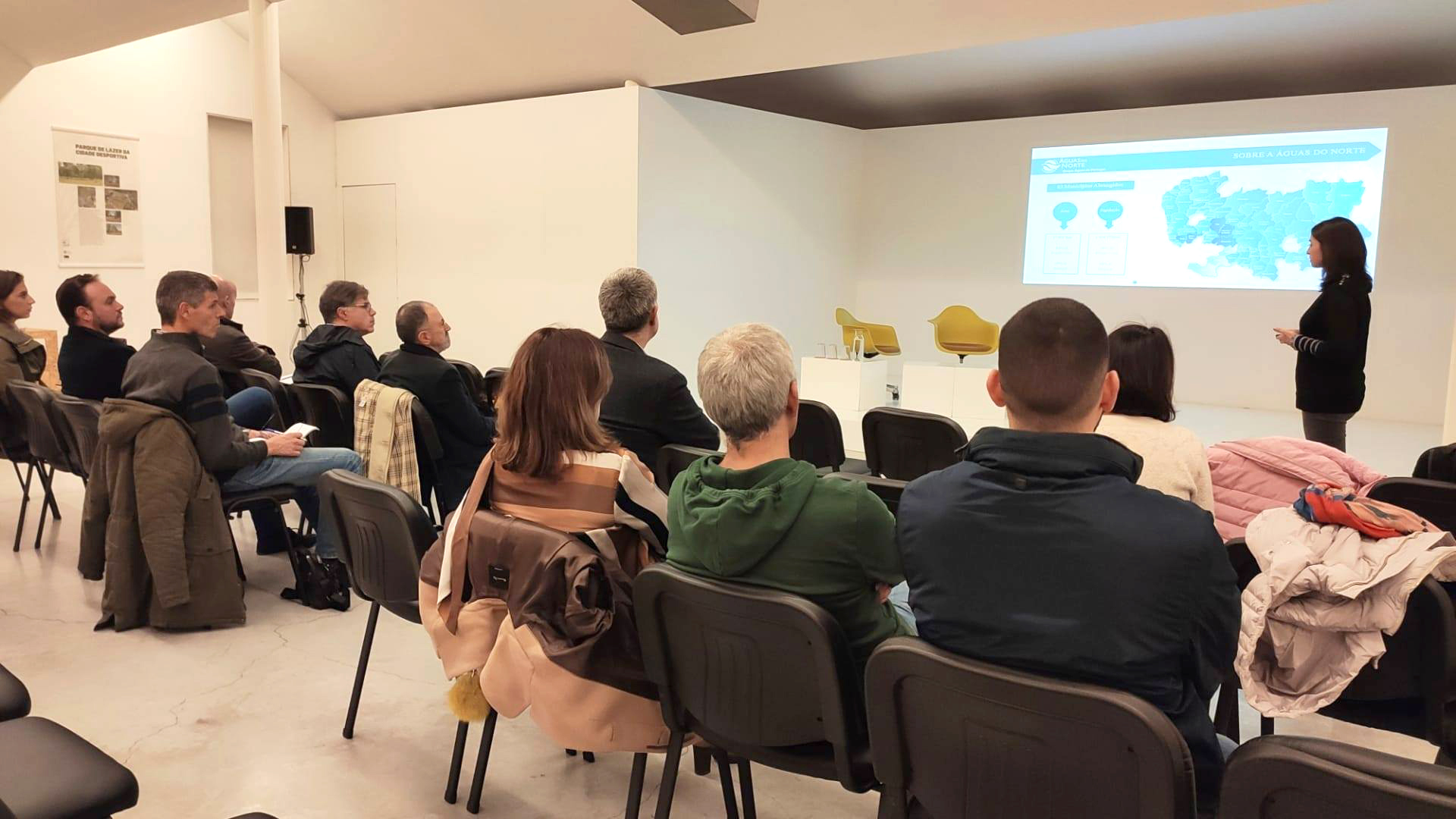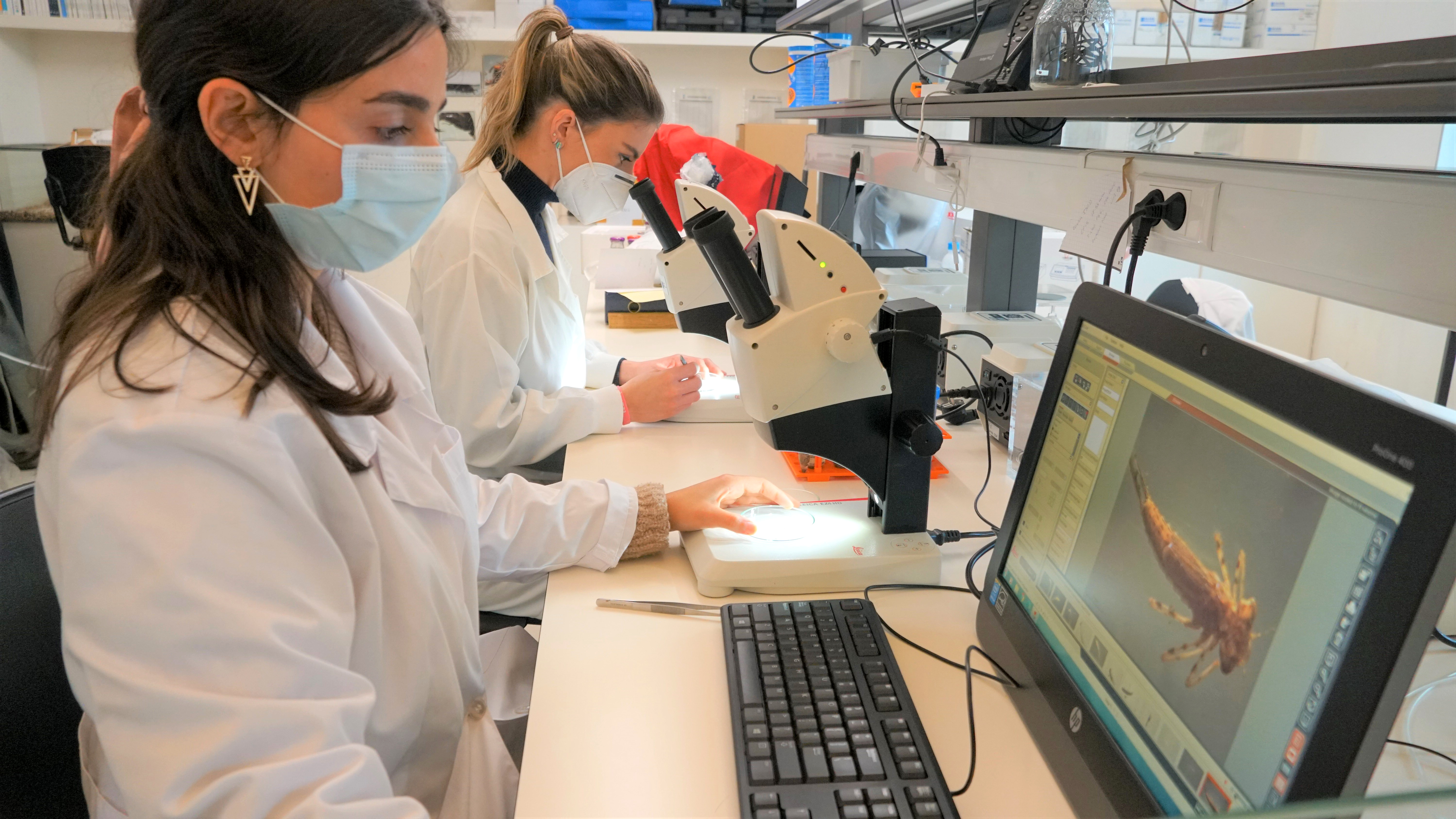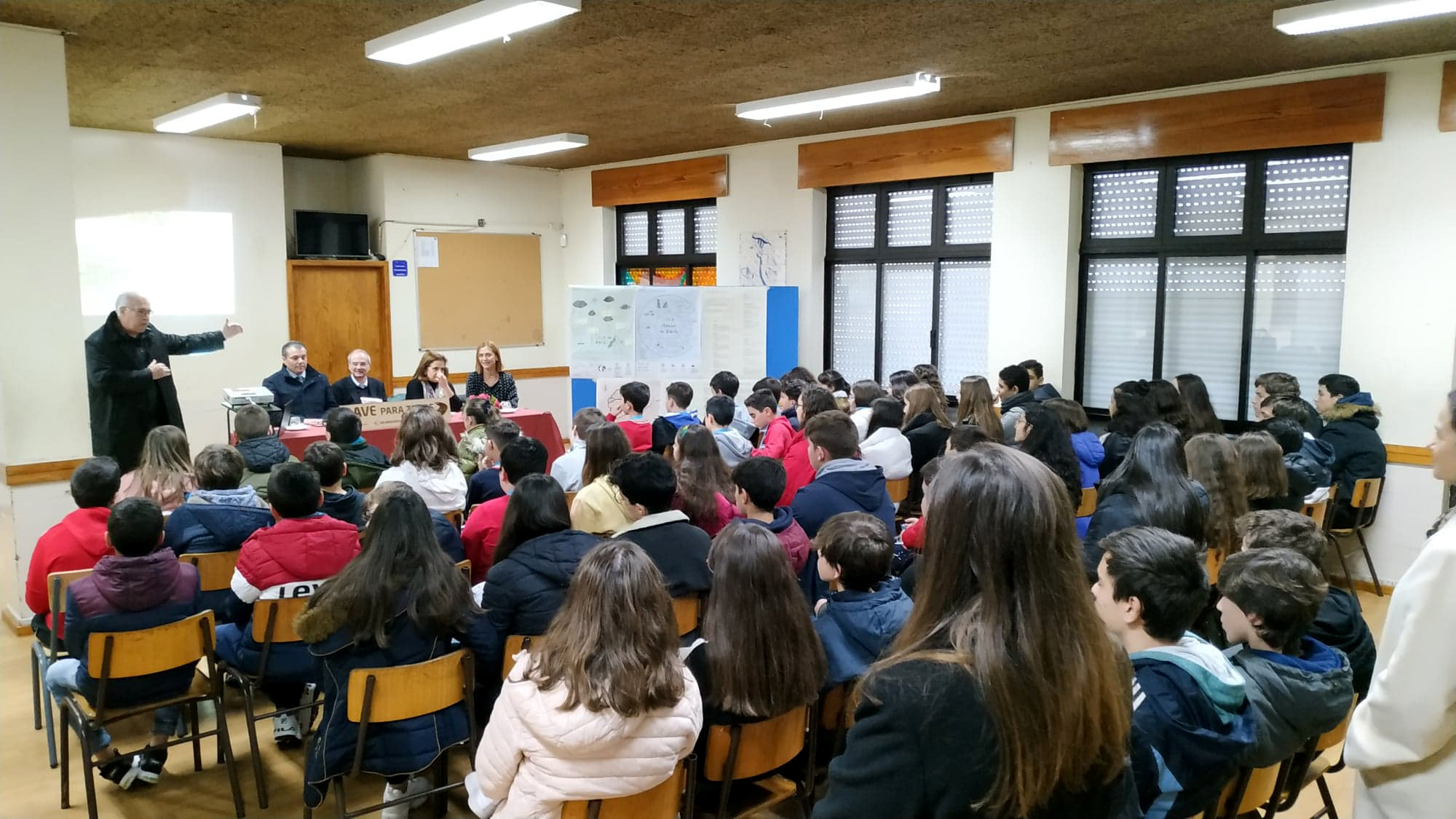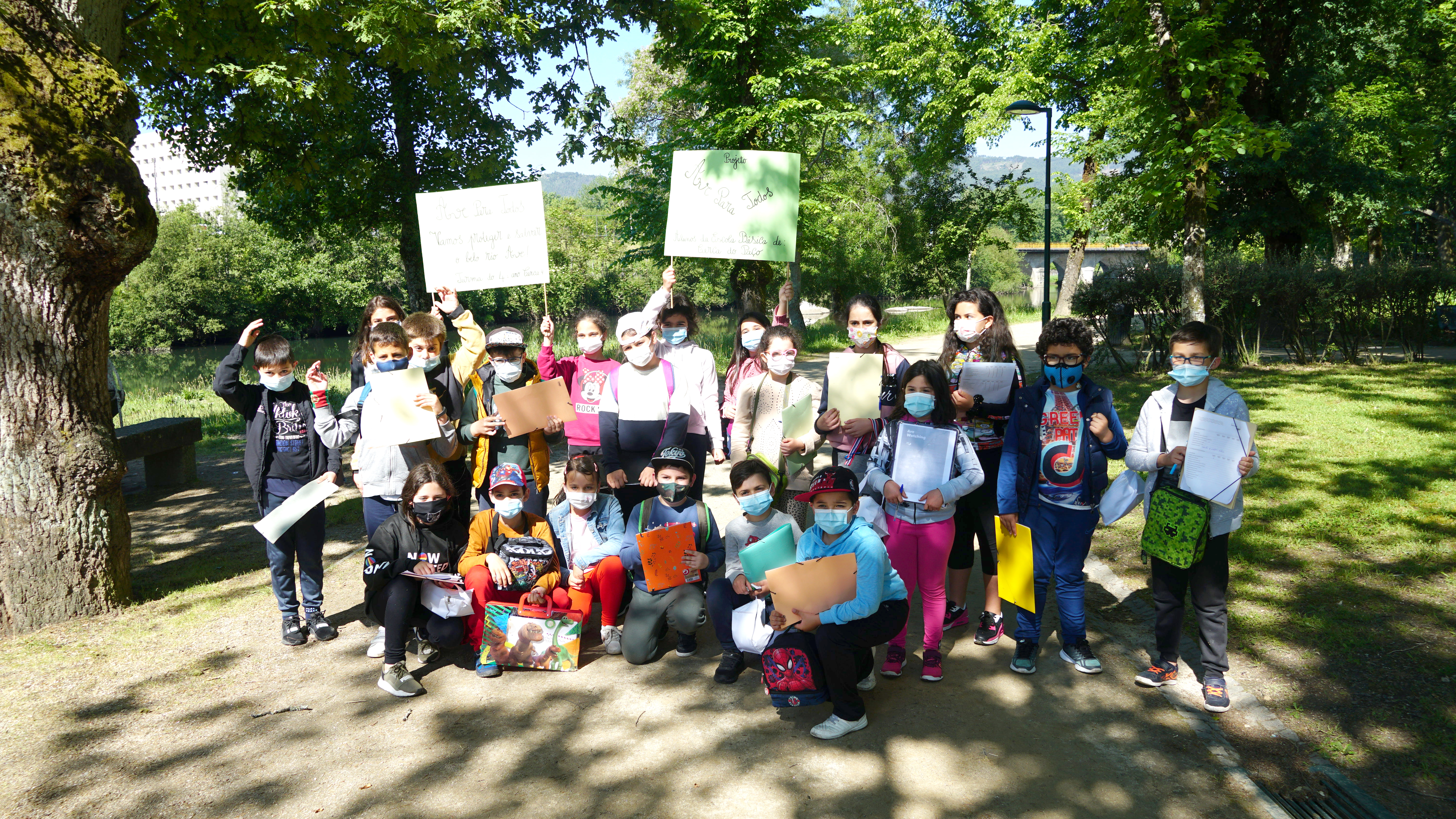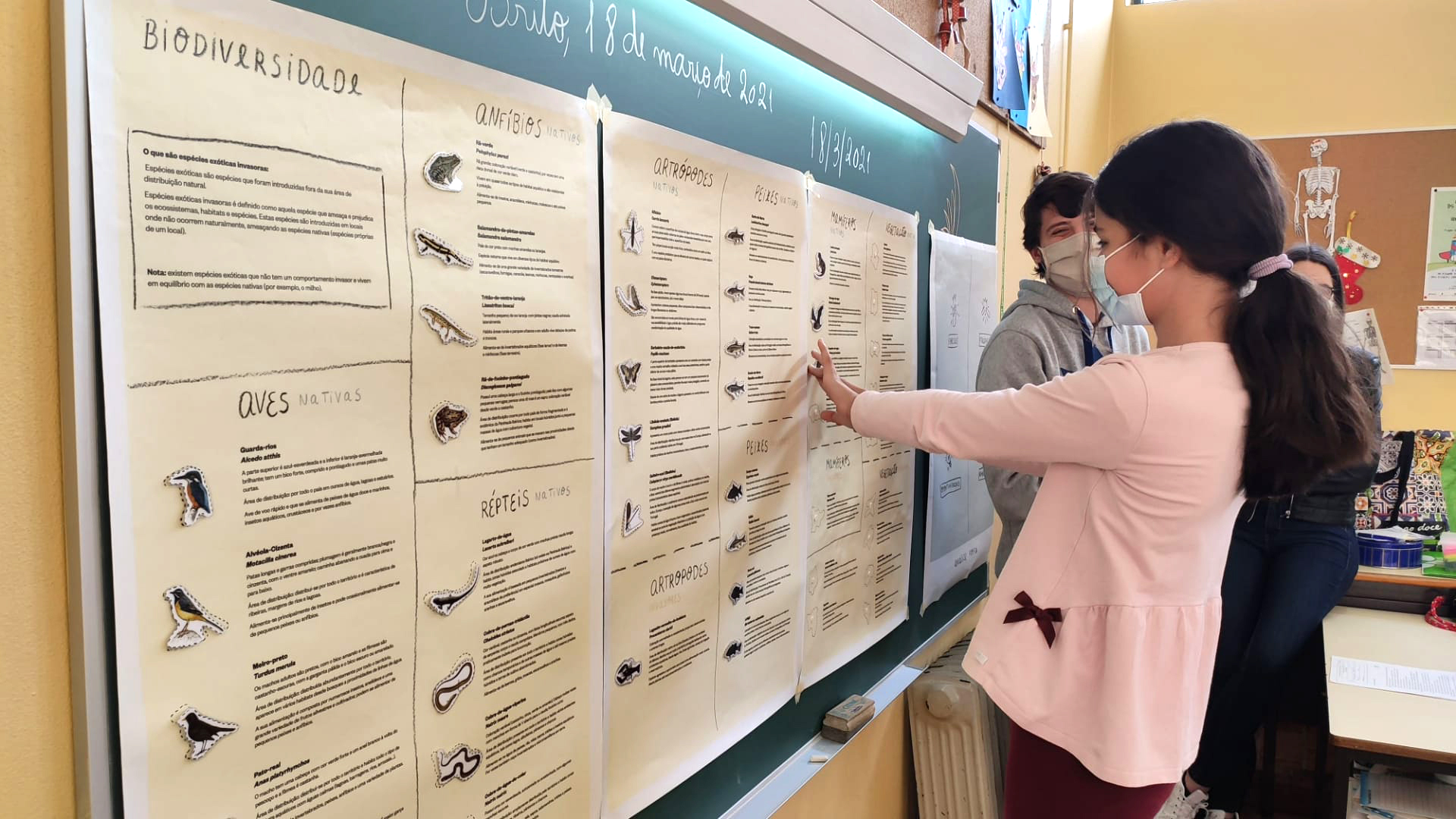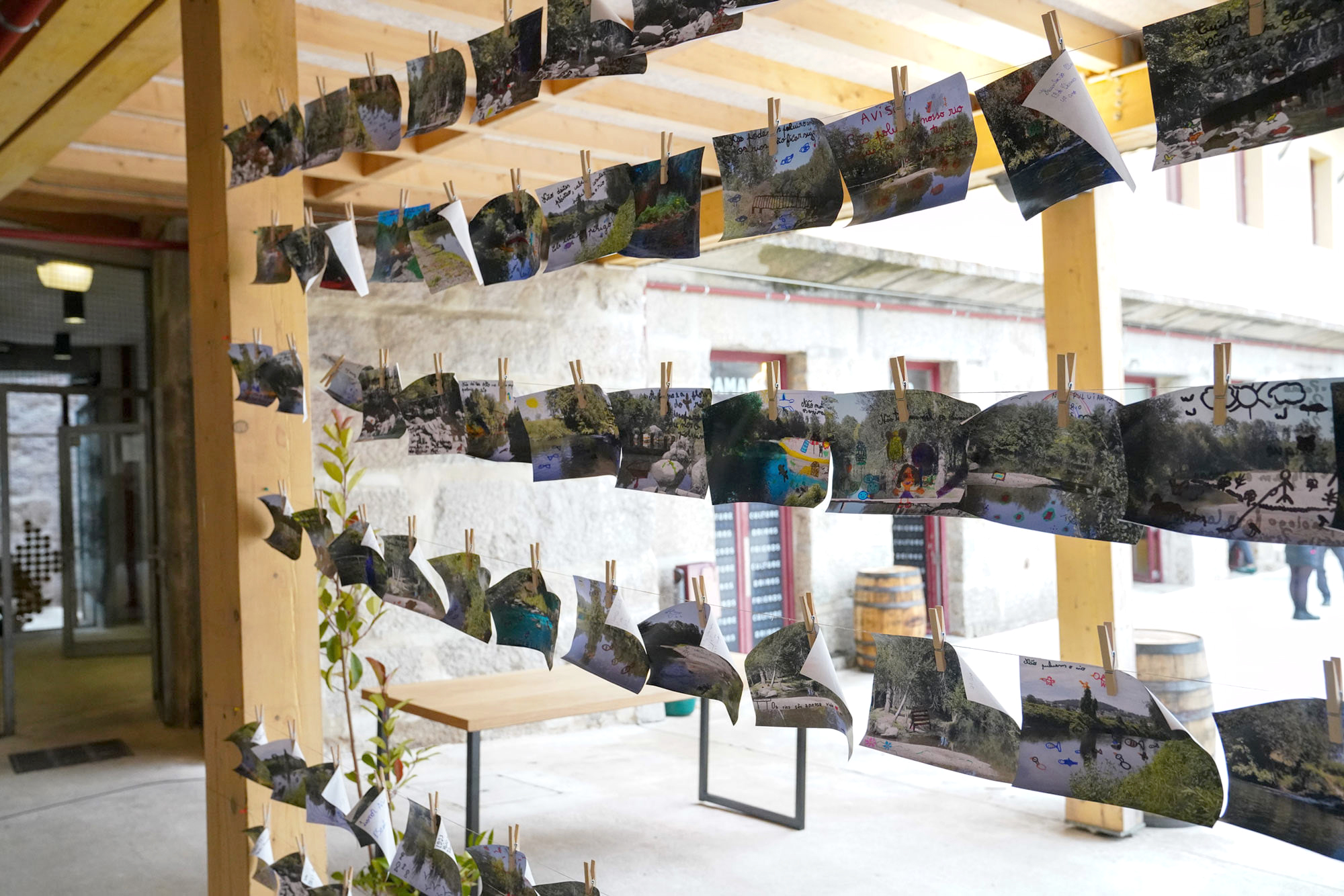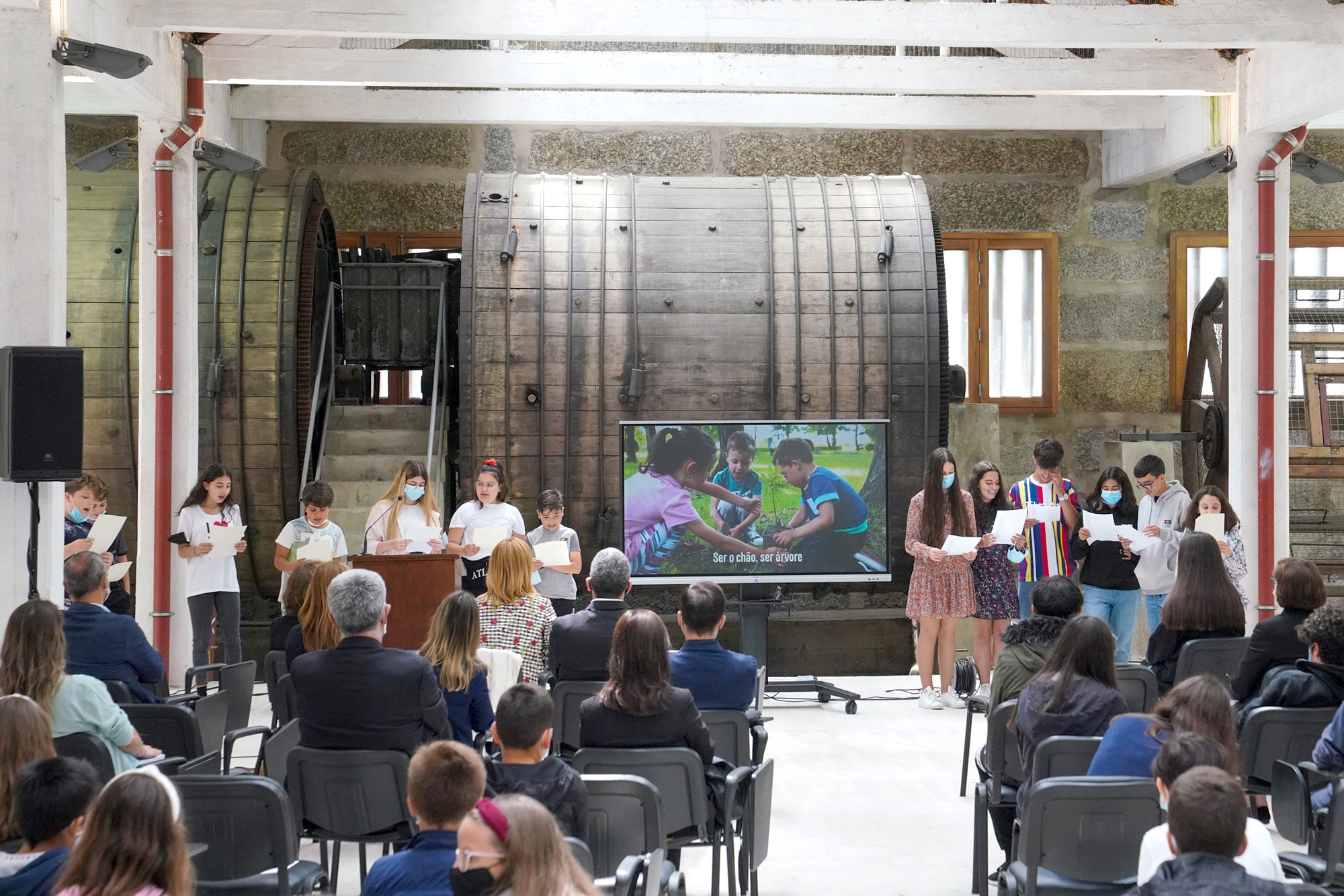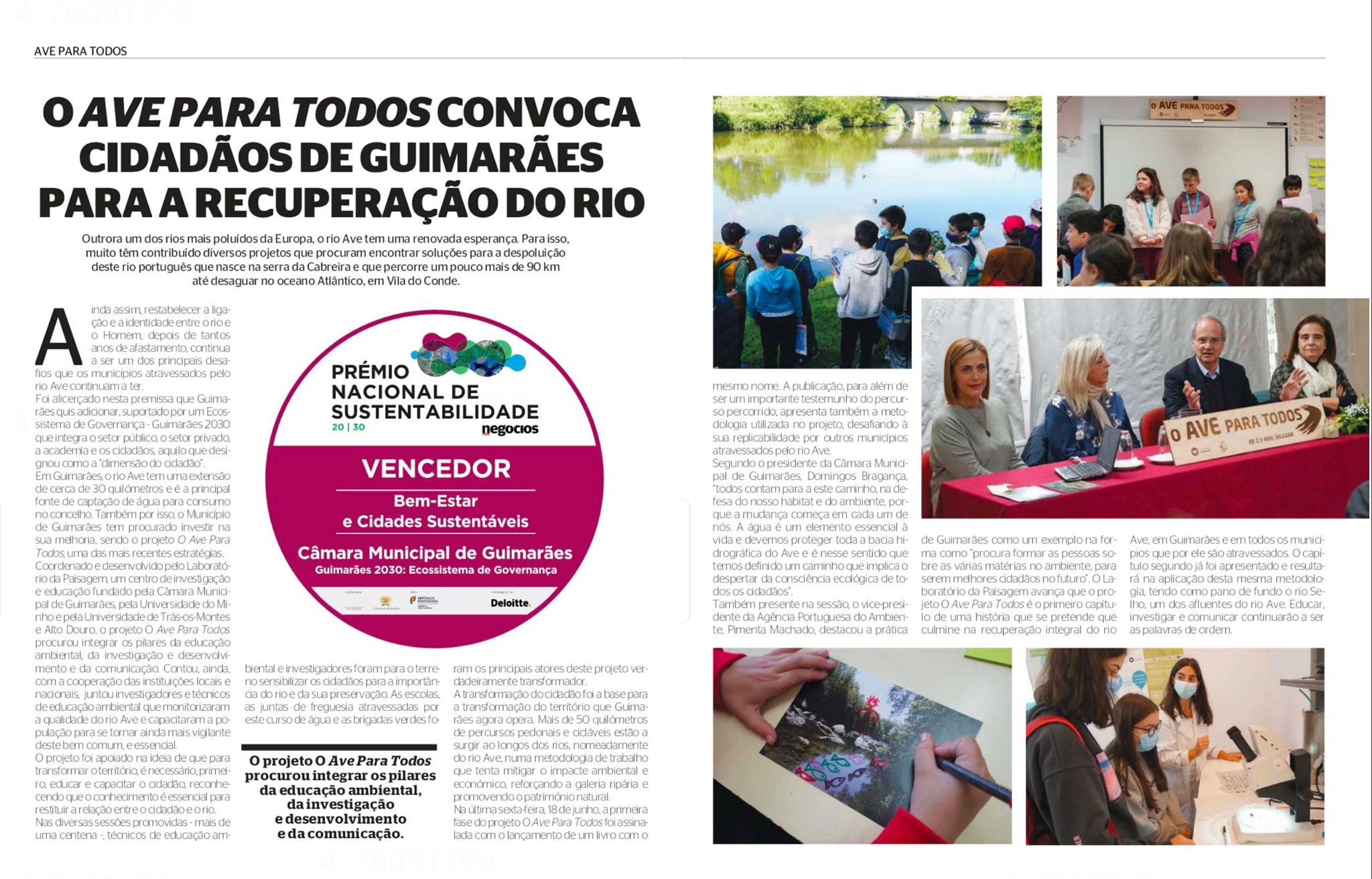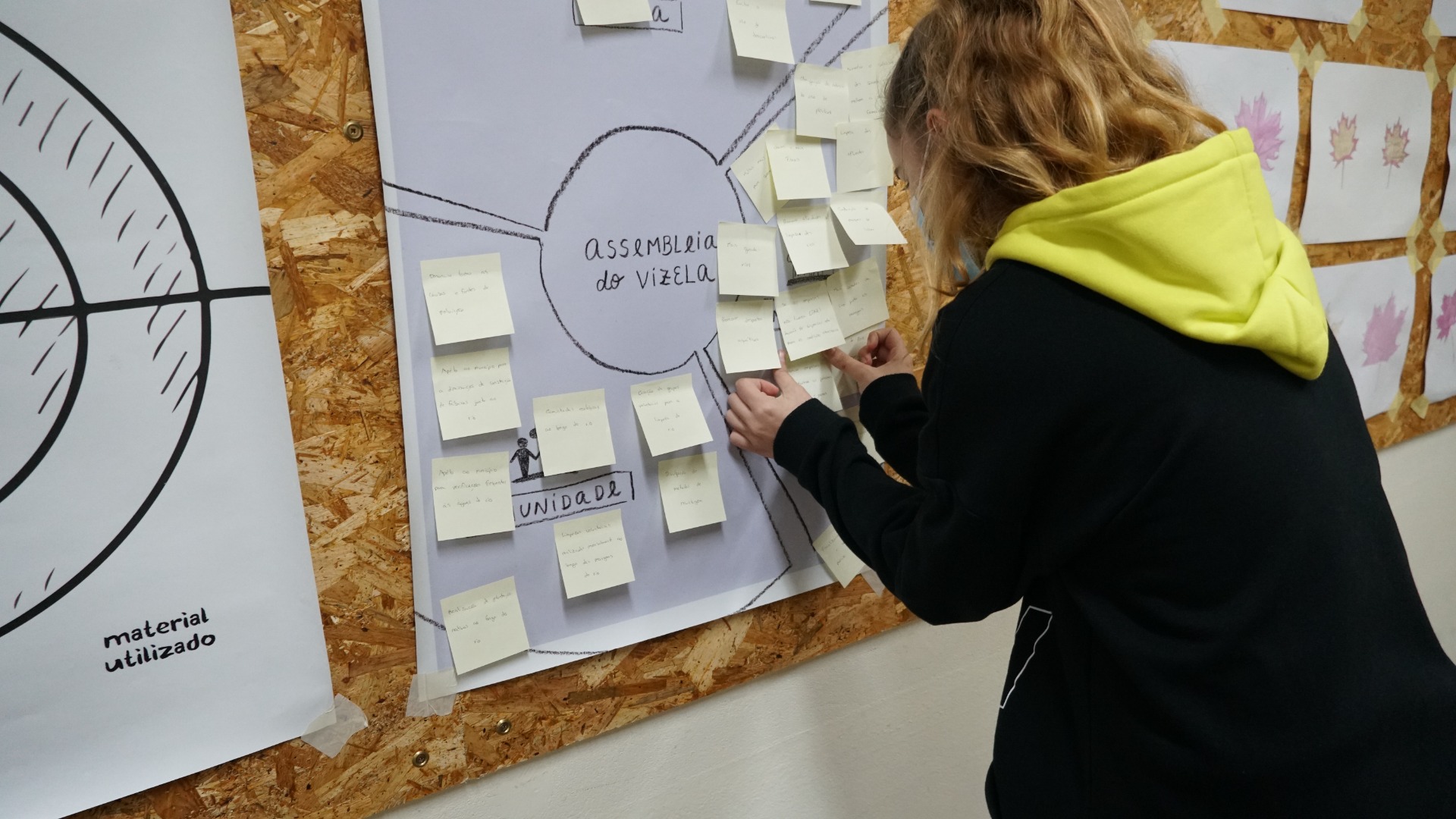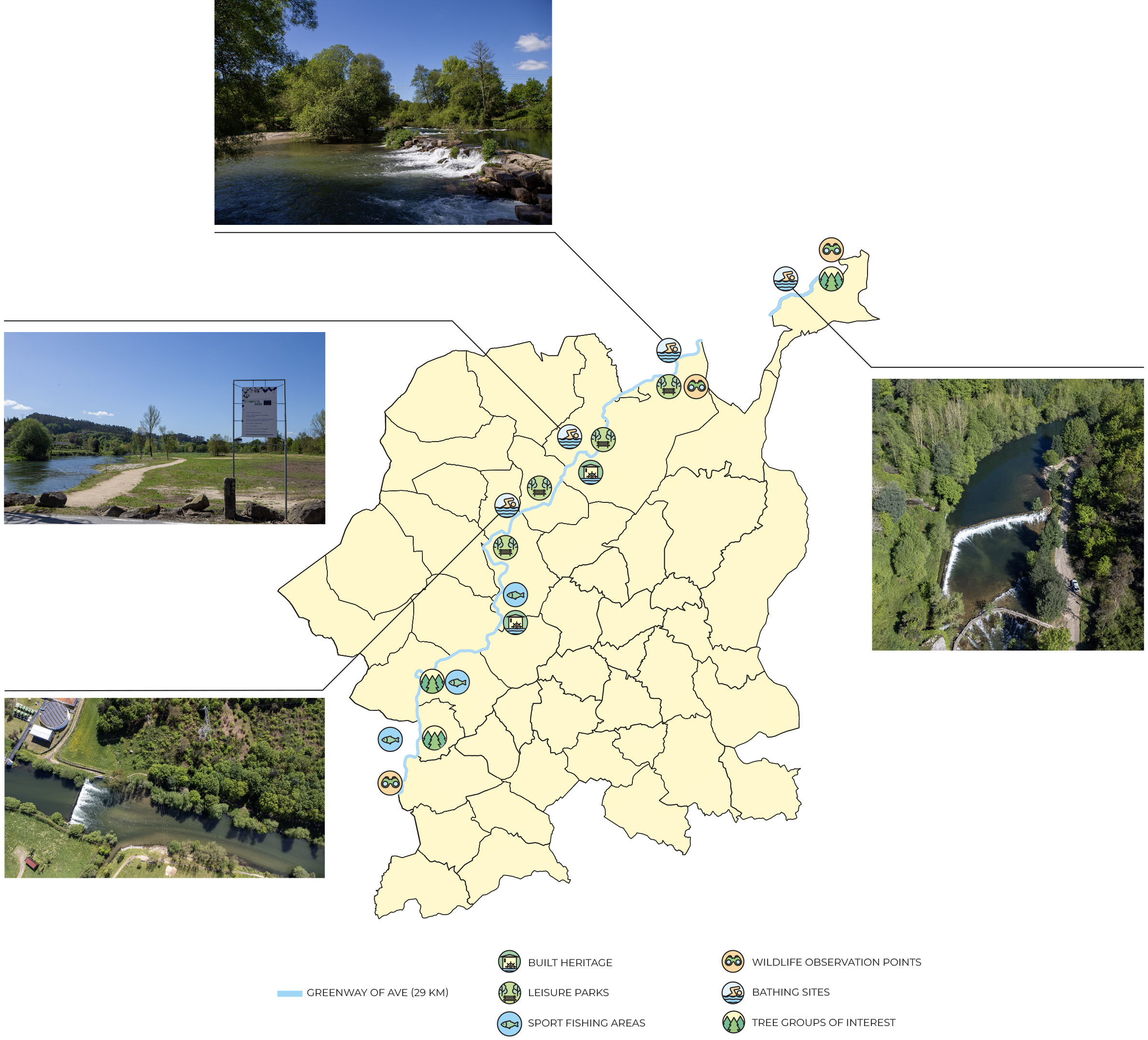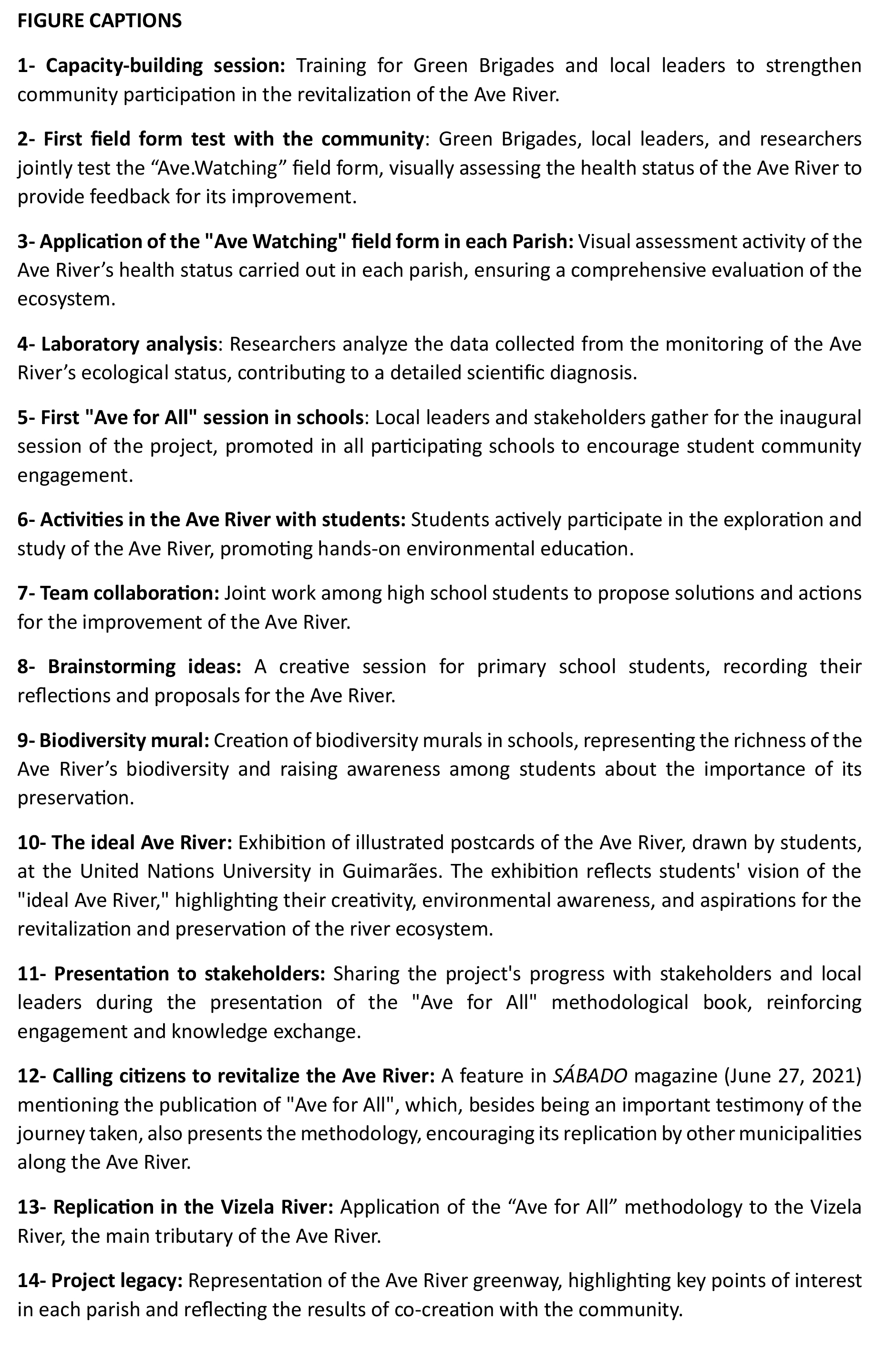Reconnecting with nature
Ave for All
Ave for All
The “Ave for All” project revives the Ave River, once one of Europe’s most polluted rivers, into a welcoming symbol of hope and renewal. Inspired by the New European Bauhaus values – sustainability, inclusivity, and aesthetics – the initiative brings together residents, students, volunteers, and local leaders. Through hands-on efforts in ecological restoration and water conservation, it demonstrates how communities can unite to shape a better, more sustainable future for all.
Portugal
Local
Guimarães
It addresses urban-rural linkages
It refers to other types of transformations (soft investment)
Yes
2021-06-30
No
No
No
As a representative of an organisation
The “Ave for All” project reflects the essence of the New European Bauhaus (NEB): sustainability, inclusivity, and aesthetics. Led by the Laboratório da Paisagem de Guimarães – a non-profit whose founding members include the Municipality of Guimarães and two respected northern Portuguese universities (University of Minho and University of Trás-os-Montes e Alto Douro) – this project has turned the Ave River from one of Europe’s most polluted waterways into a symbol of renewal and shared purpose.
Designed to reconnect the community with the 90 km-long Ave River, the initiative is more than an environmental effort. It champions sustainable water management while inspiring local residents to take an active role in protecting and restoring their natural surroundings. The project directly impacted 45,000 residents across 14 parishes in Guimarães, bringing together students from 24 schools, seven Green Brigades of dedicated volunteers, and local leaders with a common goal: safeguarding the river’s future. Participants gained hands-on experience in ecological restoration, water conservation, and sustainable practices, while fostering a deep sense of responsibility for their environment.
The project’s success is evident in the improved health of the river, greater community involvement, and stronger collaboration between community members, scientists, and policymakers. It also led to developments, such as the Ave River greenway and riverfront recreational areas that inspire leisure, connection, and well-being.
The “Ave for All” stands as a beacon of sustainable development, demonstrating that environmental recovery, cultural heritage, and community empowerment can thrive together. It highlights the strength of collective action and offers a replicable model for regions striving for a more inclusive and sustainable future.
Designed to reconnect the community with the 90 km-long Ave River, the initiative is more than an environmental effort. It champions sustainable water management while inspiring local residents to take an active role in protecting and restoring their natural surroundings. The project directly impacted 45,000 residents across 14 parishes in Guimarães, bringing together students from 24 schools, seven Green Brigades of dedicated volunteers, and local leaders with a common goal: safeguarding the river’s future. Participants gained hands-on experience in ecological restoration, water conservation, and sustainable practices, while fostering a deep sense of responsibility for their environment.
The project’s success is evident in the improved health of the river, greater community involvement, and stronger collaboration between community members, scientists, and policymakers. It also led to developments, such as the Ave River greenway and riverfront recreational areas that inspire leisure, connection, and well-being.
The “Ave for All” stands as a beacon of sustainable development, demonstrating that environmental recovery, cultural heritage, and community empowerment can thrive together. It highlights the strength of collective action and offers a replicable model for regions striving for a more inclusive and sustainable future.
Sustainability
Co-creation
Environmental Education
Community
Inclusion
The "Ave for All" project was born from the urgent need to restore the Ave River as a thriving and sustainable space where nature and people coexist in harmony. Committed to sustainability, this initiative integrates environmental conservation with active community participation, fostering a deeper connection between the river and those who live alongside it.
At its core, the project prioritizes riparian ecosystem restoration and biodiversity conservation, ensuring that human impact is minimized and natural resources are effectively protected. Water quality is a central concern, with citizens actively engaged in monitoring the river and participating in concrete actions to identify and mitigate pollution sources, gradually restoring ecological balance.
Empowering the community is also a key pillar, ensuring that the knowledge gained translates into long-lasting sustainable practices. Through educational programs and awareness initiatives, the project cultivates a collective sense of responsibility, encouraging behaviors that enhance the region’s environmental resilience. Additionally, circular economy principles and ecodesign are embedded in every aspect of the project, particularly in the development of the Ave River greenway, where natural materials and innovative solutions are used to minimize environmental impact while enhancing the landscape’s beauty.
More than an environmental initiative, "Ave for All" is a powerful example of how local action can create lasting environmental and social impact. Aligned with global challenges such as climate change adaptation, biodiversity protection, and sustainable water management, the project highlights the power of collaboration between citizens, institutions, and experts in building a more balanced and sustainable future. By bringing life back to the river, it also revives a sense of belonging and identity for the communities that depend on it.
At its core, the project prioritizes riparian ecosystem restoration and biodiversity conservation, ensuring that human impact is minimized and natural resources are effectively protected. Water quality is a central concern, with citizens actively engaged in monitoring the river and participating in concrete actions to identify and mitigate pollution sources, gradually restoring ecological balance.
Empowering the community is also a key pillar, ensuring that the knowledge gained translates into long-lasting sustainable practices. Through educational programs and awareness initiatives, the project cultivates a collective sense of responsibility, encouraging behaviors that enhance the region’s environmental resilience. Additionally, circular economy principles and ecodesign are embedded in every aspect of the project, particularly in the development of the Ave River greenway, where natural materials and innovative solutions are used to minimize environmental impact while enhancing the landscape’s beauty.
More than an environmental initiative, "Ave for All" is a powerful example of how local action can create lasting environmental and social impact. Aligned with global challenges such as climate change adaptation, biodiversity protection, and sustainable water management, the project highlights the power of collaboration between citizens, institutions, and experts in building a more balanced and sustainable future. By bringing life back to the river, it also revives a sense of belonging and identity for the communities that depend on it.
The "Ave for All" project was created to restore the Ave River to the community, transforming it into a sustainable, thriving, and valued space. More than an environmental restoration effort, it fosters a deep connection between people and the river, integrating ecological recovery, landscape design, and community engagement to enhance public spaces.
At the core of this initiative is the Ave River greenway, a 29 km continuous route that promotes sustainable mobility, environmental education, and recreation. Covering 14 parishes, it offers an immersive experience in biodiversity and incorporates Nature-based Solutions (NbS), such as riparian reforestation, which support biodiversity conservation and water management and can be replicated in other landscapes.
More than just a pathway, the greenway invites exploration. It features viewpoints, rest areas, and interpretation spaces, creating opportunities for visitors to develop a deeper, more personal connection with the river. To further strengthen cultural ties, the project includes artistic initiatives created by students, such as murals inspired by local biodiversity, which reflect the river’s historical and environmental significance.
Designed with accessibility and inclusion in mind, the greenway ensures a safe and welcoming environment for most users. Proposed informative panels and interactive installations encourage environmental literacy, helping visitors understand the importance of conservation and the river’s role in local ecosystems.
The "Ave for All" project showcases how sustainability and territorial enhancement can revitalize degraded areas, transforming them into places of education, recreation, and cultural connection. More than an environmental intervention, it strengthens community identity, ensuring the Ave River remains a place of life, culture, and well-being for present and future generations.
At the core of this initiative is the Ave River greenway, a 29 km continuous route that promotes sustainable mobility, environmental education, and recreation. Covering 14 parishes, it offers an immersive experience in biodiversity and incorporates Nature-based Solutions (NbS), such as riparian reforestation, which support biodiversity conservation and water management and can be replicated in other landscapes.
More than just a pathway, the greenway invites exploration. It features viewpoints, rest areas, and interpretation spaces, creating opportunities for visitors to develop a deeper, more personal connection with the river. To further strengthen cultural ties, the project includes artistic initiatives created by students, such as murals inspired by local biodiversity, which reflect the river’s historical and environmental significance.
Designed with accessibility and inclusion in mind, the greenway ensures a safe and welcoming environment for most users. Proposed informative panels and interactive installations encourage environmental literacy, helping visitors understand the importance of conservation and the river’s role in local ecosystems.
The "Ave for All" project showcases how sustainability and territorial enhancement can revitalize degraded areas, transforming them into places of education, recreation, and cultural connection. More than an environmental intervention, it strengthens community identity, ensuring the Ave River remains a place of life, culture, and well-being for present and future generations.
The "Ave for All" project was designed to restore the Ave River by actively engaging the local community in its conservation. Rather than being passive observers, residents became key players in environmental protection, learning how to care for their natural surroundings and contribute to the river’s recovery.
A central pillar of the project was education and capacity building. Through workshops and hands-on training, volunteers, local leaders, and students were given the tools to visually monitor the health status of the river, track biodiversity, and identify pollution sources. This approach empowered the community with practical knowledge and long-term skills for river conservation.
A defining feature of "Ave for All" was its commitment to citizen science. Residents played an active role in collecting environmental data and applying solutions such as removing invasive species, planting native trees, and organizing clean-up activities, directly improving the river’s ecosystem.
The project also fostered strong partnerships with key institutions like Vimágua, Águas do Norte, and the Portuguese Environment Agency, alongside universities and Green Brigades. This collaborative network ensured a comprehensive, science-based, and community-driven approach to water resource management.
Beyond conservation efforts, the project used social media, public talks, and community events to raise awareness and promote behavioral change. These initiatives strengthened the bond between people and the river, fostering a renewed sense of collective responsibility.
The impact of "Ave for All" is evident in the increased community participation, greater environmental awareness, and a shared commitment to river protection. By equipping citizens with knowledge and a voice in conservation, the project proved that local communities can be leaders in sustainability, ensuring a healthier, more resilient future for their ecosystems.
A central pillar of the project was education and capacity building. Through workshops and hands-on training, volunteers, local leaders, and students were given the tools to visually monitor the health status of the river, track biodiversity, and identify pollution sources. This approach empowered the community with practical knowledge and long-term skills for river conservation.
A defining feature of "Ave for All" was its commitment to citizen science. Residents played an active role in collecting environmental data and applying solutions such as removing invasive species, planting native trees, and organizing clean-up activities, directly improving the river’s ecosystem.
The project also fostered strong partnerships with key institutions like Vimágua, Águas do Norte, and the Portuguese Environment Agency, alongside universities and Green Brigades. This collaborative network ensured a comprehensive, science-based, and community-driven approach to water resource management.
Beyond conservation efforts, the project used social media, public talks, and community events to raise awareness and promote behavioral change. These initiatives strengthened the bond between people and the river, fostering a renewed sense of collective responsibility.
The impact of "Ave for All" is evident in the increased community participation, greater environmental awareness, and a shared commitment to river protection. By equipping citizens with knowledge and a voice in conservation, the project proved that local communities can be leaders in sustainability, ensuring a healthier, more resilient future for their ecosystems.
The "Ave for All" united diverse stakeholders to ensure a long-term impact on the conservation of the Ave River. The Municipality of Guimarães provided financial, political, and logistical support, while universities contributed scientific expertise for environmental monitoring and sustainable practices. Green Brigades and parish council presidents mobilized volunteers, leading community-driven initiatives for river restoration.
At a national and European level, the project aligned with EU environmental strategies, increasing its replication potential. Key organizations, including Vimágua, Águas do Norte, and the Portuguese Environment Agency, supported ecological restoration efforts and provided training for volunteers and local leaders.
Between October 2019 and February 2020, five training sessions were conducted to deepen community involvement. The first session explored the main environmental challenges of the river, while the second emphasized its ecological, cultural, and historical significance. The third focused on invasive species management and riparian restoration, and the fourth introduced local biodiversity, culminating in a field trip to test "Ave.Watching", a citizen-led environmental monitoring tool. The fifth session expanded this effort, testing the field form across all 14 parishes in Guimarães through which the Ave River flows, ensuring its adaptability to different contexts.
These sessions fostered knowledge exchange between experts and citizens, covering topics such as river maintenance, identifying responsible entities, and environmental reporting. Municipal services shared operational challenges like drain blockages and flood prevention, empowering the community to take an active role in addressing these issues.
This collaborative approach strengthened the connection between science, public administration, and the community, promoting sustainable practices and participatory governance to secure the long-term protection of the Ave River.
At a national and European level, the project aligned with EU environmental strategies, increasing its replication potential. Key organizations, including Vimágua, Águas do Norte, and the Portuguese Environment Agency, supported ecological restoration efforts and provided training for volunteers and local leaders.
Between October 2019 and February 2020, five training sessions were conducted to deepen community involvement. The first session explored the main environmental challenges of the river, while the second emphasized its ecological, cultural, and historical significance. The third focused on invasive species management and riparian restoration, and the fourth introduced local biodiversity, culminating in a field trip to test "Ave.Watching", a citizen-led environmental monitoring tool. The fifth session expanded this effort, testing the field form across all 14 parishes in Guimarães through which the Ave River flows, ensuring its adaptability to different contexts.
These sessions fostered knowledge exchange between experts and citizens, covering topics such as river maintenance, identifying responsible entities, and environmental reporting. Municipal services shared operational challenges like drain blockages and flood prevention, empowering the community to take an active role in addressing these issues.
This collaborative approach strengthened the connection between science, public administration, and the community, promoting sustainable practices and participatory governance to secure the long-term protection of the Ave River.
"Ave for All" united diverse stakeholders to ensure a long-term impact on the conservation of the Ave River. The Municipality of Guimarães provided financial, political, and logistical support, while universities contributed scientific expertise for environmental monitoring and sustainable practices. Green Brigades and parish council presidents mobilized volunteers, leading community-driven initiatives for river restoration.
At a national and European level, the project aligned with EU environmental strategies, increasing its replication potential. Key organizations, including Vimágua, Águas do Norte, and the Portuguese Environment Agency, supported ecological restoration efforts and provided training for volunteers and local leaders.
Between October 2019 and February 2020, five training sessions were conducted to deepen community involvement. The first session explored the main environmental challenges of the river, while the second emphasized its ecological, cultural, and historical significance. The third focused on invasive species management and riparian restoration, and the fourth introduced local biodiversity, culminating in a field expedition to test "Ave.Watching", a citizen-led environmental monitoring tool. The fifth session expanded this effort, testing the field form across all 14 parishes in Guimarães through which the Ave River flows, ensuring its adaptability to different contexts.
These sessions fostered knowledge exchange between experts and citizens, covering topics such as river maintenance, identifying responsible entities, and environmental reporting. Municipal services shared operational challenges like drain blockages and flood prevention, empowering the community to take an active role in addressing these issues.
This collaborative approach strengthened the connection between science, public administration, and the community, promoting sustainable practices and participatory governance to secure the long-term protection of the Ave River.
At a national and European level, the project aligned with EU environmental strategies, increasing its replication potential. Key organizations, including Vimágua, Águas do Norte, and the Portuguese Environment Agency, supported ecological restoration efforts and provided training for volunteers and local leaders.
Between October 2019 and February 2020, five training sessions were conducted to deepen community involvement. The first session explored the main environmental challenges of the river, while the second emphasized its ecological, cultural, and historical significance. The third focused on invasive species management and riparian restoration, and the fourth introduced local biodiversity, culminating in a field expedition to test "Ave.Watching", a citizen-led environmental monitoring tool. The fifth session expanded this effort, testing the field form across all 14 parishes in Guimarães through which the Ave River flows, ensuring its adaptability to different contexts.
These sessions fostered knowledge exchange between experts and citizens, covering topics such as river maintenance, identifying responsible entities, and environmental reporting. Municipal services shared operational challenges like drain blockages and flood prevention, empowering the community to take an active role in addressing these issues.
This collaborative approach strengthened the connection between science, public administration, and the community, promoting sustainable practices and participatory governance to secure the long-term protection of the Ave River.
The "Ave for All" project adopted a collaborative and interdisciplinary approach to restore and protect the Ave River, bringing together environmental science, urban planning, education, and culture to develop sustainable solutions that balance ecological preservation, territorial enhancement, and community engagement.
In the field of environmental sciences, experts conducted water quality assessments, biodiversity monitoring, and ecological restoration strategies, ensuring that interventions aligned with sustainability principles and promoted ecosystem resilience.
Urban planning and landscape architecture were key in planning green infrastructure, public spaces, and the river greenway, making the river more accessible and integrated into the urban landscape, while reinforcing its value for the community.
Community engagement played a fundamental role in the project’s success. Green Brigades and parish council leaders mobilized local residents through awareness campaigns and volunteer actions, encouraging citizens to protect the river and adopt environmentally responsible practices.
In education and communication, the project emphasized youth involvement through five practical sessions in the PEGADAS municipal environmental education program, promoted by the Municipality of Guimarães and the Laboratório da Paisagem. Activities like biodiversity murals and illustrated postcards inspired young people, reinforcing their emotional and cultural connection to the river.
Collaboration was further strengthened through workshops, meetings, and practical sessions, fostering the exchange of ideas and the development of innovative solutions. This participatory approach had a real impact, empowering the community to take an active role in safeguarding the Ave River.
By combining scientific expertise with local participation, the project ensured its actions were technically sound, community-driven, and sustainable in the long term.
In the field of environmental sciences, experts conducted water quality assessments, biodiversity monitoring, and ecological restoration strategies, ensuring that interventions aligned with sustainability principles and promoted ecosystem resilience.
Urban planning and landscape architecture were key in planning green infrastructure, public spaces, and the river greenway, making the river more accessible and integrated into the urban landscape, while reinforcing its value for the community.
Community engagement played a fundamental role in the project’s success. Green Brigades and parish council leaders mobilized local residents through awareness campaigns and volunteer actions, encouraging citizens to protect the river and adopt environmentally responsible practices.
In education and communication, the project emphasized youth involvement through five practical sessions in the PEGADAS municipal environmental education program, promoted by the Municipality of Guimarães and the Laboratório da Paisagem. Activities like biodiversity murals and illustrated postcards inspired young people, reinforcing their emotional and cultural connection to the river.
Collaboration was further strengthened through workshops, meetings, and practical sessions, fostering the exchange of ideas and the development of innovative solutions. This participatory approach had a real impact, empowering the community to take an active role in safeguarding the Ave River.
By combining scientific expertise with local participation, the project ensured its actions were technically sound, community-driven, and sustainable in the long term.
The "Ave for All" stands out for its innovative approach to river conservation, fostering ecological regeneration through active community participation. Instead of relying solely on experts, it integrates citizen science, empowering residents to monitor the Ave River’s health, collect data on biodiversity (using the local biodiversity app, BiodiversityGo!), and contribute to its preservation. This inclusive methodology makes conservation more accessible, strengthens local engagement, and reinforces a deep sense of belonging to the territory.
A key innovation of the project is its participatory governance model, where municipalities, universities, environmental organizations, and the local community collaborate to co-design and implement solutions tailored to regional needs. This cooperative approach ensures a diverse range of perspectives, leading to more effective and sustainable planning.
The project also distinguishes itself through its multidisciplinary framework, integrating scientific knowledge with education and artistic expression to raise environmental awareness. Beyond ecological restoration efforts, cultural and educational activities such illustrated postcards of an ideal Ave River created by students have helped forge an emotional connection with the river, inspiring sustainable behaviors.
Technology plays a crucial role in enhancing project outreach, utilizing digital tools such as BiodiversityGO! mobile application and GIS mapping, making environmental monitoring more efficient, transparent, and accessible.
Another defining feature is its emphasis on behavioral change through education and active participation. Green Brigades help embed sustainable habits in the community, transforming river protection into a shared responsibility.
The "Ave for All" project not only redefines environmental conservation but also serves as a scalable and replicable model, inspiring communities to embrace ecological regeneration sustainably.
A key innovation of the project is its participatory governance model, where municipalities, universities, environmental organizations, and the local community collaborate to co-design and implement solutions tailored to regional needs. This cooperative approach ensures a diverse range of perspectives, leading to more effective and sustainable planning.
The project also distinguishes itself through its multidisciplinary framework, integrating scientific knowledge with education and artistic expression to raise environmental awareness. Beyond ecological restoration efforts, cultural and educational activities such illustrated postcards of an ideal Ave River created by students have helped forge an emotional connection with the river, inspiring sustainable behaviors.
Technology plays a crucial role in enhancing project outreach, utilizing digital tools such as BiodiversityGO! mobile application and GIS mapping, making environmental monitoring more efficient, transparent, and accessible.
Another defining feature is its emphasis on behavioral change through education and active participation. Green Brigades help embed sustainable habits in the community, transforming river protection into a shared responsibility.
The "Ave for All" project not only redefines environmental conservation but also serves as a scalable and replicable model, inspiring communities to embrace ecological regeneration sustainably.
The "Ave for All" integrates scientific research, environmental education, and community engagement to promote sustainable river conservation. By involving scientists, local authorities, government entities, and citizens, it fosters a collaborative water management model that balances ecological preservation with human activities.
Focusing on behavioral change, the project ensures long-term commitment through education, monitoring, and citizen participation. It’s structured around three key pillars: Environmental Education and Awareness, equipping the community with tools to monitor and protect the river; Research and Development, conducting ecological assessments and guiding restoration efforts; and Communication and Engagement, using outreach campaigns and public initiatives to encourage environmental responsibility.
Education played a central role, with 24 schools participating in hands-on activities like SWOT analyses, policy debates, and field trips (5 sessions/school; total 120). Additionally, five training sessions and 14 field trips engaged volunteers, local leaders, and environmental experts, standardizing conservation practices across different parishes.
Over one year, scientific monitoring at 11 sites identified key challenges such as high phosphorus levels and invasive species. In response targeted restoration actions, including removing invasive plants, replanting native vegetation, and strengthening partnerships with environmental agencies.
To reinforce the community’s connection with the river, the project launched awareness campaigns and art-based initiatives, while developed plans for a greenway along the river (attached)
For long-term impact, an e-book on methodologies and best practices and a scientific article on ecological monitoring and citizen engagement were published, ensuring that "Ave for All" remains a scalable and replicable model for river conservation.
Focusing on behavioral change, the project ensures long-term commitment through education, monitoring, and citizen participation. It’s structured around three key pillars: Environmental Education and Awareness, equipping the community with tools to monitor and protect the river; Research and Development, conducting ecological assessments and guiding restoration efforts; and Communication and Engagement, using outreach campaigns and public initiatives to encourage environmental responsibility.
Education played a central role, with 24 schools participating in hands-on activities like SWOT analyses, policy debates, and field trips (5 sessions/school; total 120). Additionally, five training sessions and 14 field trips engaged volunteers, local leaders, and environmental experts, standardizing conservation practices across different parishes.
Over one year, scientific monitoring at 11 sites identified key challenges such as high phosphorus levels and invasive species. In response targeted restoration actions, including removing invasive plants, replanting native vegetation, and strengthening partnerships with environmental agencies.
To reinforce the community’s connection with the river, the project launched awareness campaigns and art-based initiatives, while developed plans for a greenway along the river (attached)
For long-term impact, an e-book on methodologies and best practices and a scientific article on ecological monitoring and citizen engagement were published, ensuring that "Ave for All" remains a scalable and replicable model for river conservation.
The "Ave for All" is a powerful example of how collaboration between communities, local organizations, and experts can drive meaningful environmental change. Its scalable model allows the knowledge and experience gained to be replicated or adapted to different regions and contexts, making it a benchmark for similar initiatives.
At its core, the project is built on a flexible citizen science model, where participatory monitoring methods and accessible tools empower communities to take the lead in environmental assessments. This approach can be easily applied to other river systems. At the same time, nature-based solutions, such as riparian reforestation and ecological restoration techniques, demonstrate effective ways to recover ecosystems and improve water management, serving as an inspiration for different landscapes and realities.
Community engagement is one of the project's key pillars. Through education and capacity-building strategies, it fosters active citizen participation in environmental conservation, creating a replicable model for other regions. In addition, collaborative governance, supported by a network of municipality, universities, local organisations, and community groups, establishes an effective management framework that can be adopted in various geographic contexts.
A distinctive feature of "Ave for All" is its use of cultural and artistic approaches to promote ecological awareness. Art and culture serve as powerful tools to strengthen the connection between people and their environment, ensuring that conservation messages are communicated in an accessible and engaging way, regardless of sociocultural background.
By showing that community-led conservation is both effective and sustainable, "Ave para Todos" offers a scalable model that can be adopted globally, placing communities at the core of ecosystem preservation.
At its core, the project is built on a flexible citizen science model, where participatory monitoring methods and accessible tools empower communities to take the lead in environmental assessments. This approach can be easily applied to other river systems. At the same time, nature-based solutions, such as riparian reforestation and ecological restoration techniques, demonstrate effective ways to recover ecosystems and improve water management, serving as an inspiration for different landscapes and realities.
Community engagement is one of the project's key pillars. Through education and capacity-building strategies, it fosters active citizen participation in environmental conservation, creating a replicable model for other regions. In addition, collaborative governance, supported by a network of municipality, universities, local organisations, and community groups, establishes an effective management framework that can be adopted in various geographic contexts.
A distinctive feature of "Ave for All" is its use of cultural and artistic approaches to promote ecological awareness. Art and culture serve as powerful tools to strengthen the connection between people and their environment, ensuring that conservation messages are communicated in an accessible and engaging way, regardless of sociocultural background.
By showing that community-led conservation is both effective and sustainable, "Ave para Todos" offers a scalable model that can be adopted globally, placing communities at the core of ecosystem preservation.
The "Ave for All" project is a powerful example of how local, community-driven initiatives can provide effective solutions to global environmental challenges. By restoring riparian vegetation and implementing nature-based solutions, the project helps ecosystems adapt to climate change, reducing the impact of floods and droughts while strengthening overall resilience. It also plays a vital role in sustainable water management, engaging local communities in monitoring water quality, promoting conservation practices, and preventing pollution, contributing to global efforts to protect freshwater ecosystems.
At its core, the project is deeply committed to biodiversity conservation, restoring degraded habitats, controling invasive species, and fostering native plant and animal populations. This hands-on approach directly supports international goals to preserve biodiversity and restore ecological balance. Education is another key pillar, as "Ave for All" prioritizes environmental awareness and community empowerment through workshops, training sessions, and hands-on learning experiences. By fostering a sense of responsibility and connection to nature, the project equips people with the knowledge and motivation to take action, not just locally, but on a broader scale.
Beyond conservation, the initiative embraces circular economy principles, encouraging sustainable resource use, waste reduction, and eco-friendly design solutions. These efforts contribute to a global movement toward smarter, more sustainable consumption and production practices.
By integrating these diverse strategies, "Ave for All" proves that small-scale, community-led interventions can have a far-reaching impact. It offers a replicable model for tackling important environmental issues worldwide, demonstrating that real change begins at the local level, with people taking the lead in shaping a more sustainable future.
At its core, the project is deeply committed to biodiversity conservation, restoring degraded habitats, controling invasive species, and fostering native plant and animal populations. This hands-on approach directly supports international goals to preserve biodiversity and restore ecological balance. Education is another key pillar, as "Ave for All" prioritizes environmental awareness and community empowerment through workshops, training sessions, and hands-on learning experiences. By fostering a sense of responsibility and connection to nature, the project equips people with the knowledge and motivation to take action, not just locally, but on a broader scale.
Beyond conservation, the initiative embraces circular economy principles, encouraging sustainable resource use, waste reduction, and eco-friendly design solutions. These efforts contribute to a global movement toward smarter, more sustainable consumption and production practices.
By integrating these diverse strategies, "Ave for All" proves that small-scale, community-led interventions can have a far-reaching impact. It offers a replicable model for tackling important environmental issues worldwide, demonstrating that real change begins at the local level, with people taking the lead in shaping a more sustainable future.
The "Ave for All" project has had a lasting environmental and social impact, demonstrating the power of community-driven conservation. Through sustainable water management and ecological restoration, it helped improve Ave River’s water quality, restore riparian vegetation, and boost biodiversity by controlling invasive plant species and enhancing ecosystem resilience.
At the heart of this success is community involvement. Over 900 participants, including students, volunteers, and local stakeholders, have engaged in educational and hands-on activities, becoming Ave river ambassadors who identify threats, promote conservation, and advocate for sustainability. Through training sessions, school programs, and public events, the project has fostered environmental responsibility, especially among youth, empowering them to protect natural resources.
"Ave for All" has become a replicable model, with its methodologies applied in "Selho for All" and "Vizela for All", expanding conservation efforts to the Selho and Vizela rivers (both tributaries of the Ave River), and inspiring similar initiatives in the municipality of Póvoa de Varzim (within the Ave River basin), where a school has adopted its environmental education approach. It has also influenced policy and new conservation projects, contributing to riverbank restoration through REACTivar Guimarães (REACT-EU programme, 2022-2023) and supporting plastic waste reduction through the BluePoint Project (Interreg Atlantic Area Programme, 2023-2026). Additionally, the project played a key role in shaping a new Ave River Greenway, strengthening the link between conservation, recreation, and sustainable land use.
By combining scientific research, community engagement, and ecological restoration, "Ave for All" demonstrates how local action can drive global change. It has empowered communities to take responsibility for their environment, ensuring the long-term sustainability of both ecosystems and the people who depend on them.
At the heart of this success is community involvement. Over 900 participants, including students, volunteers, and local stakeholders, have engaged in educational and hands-on activities, becoming Ave river ambassadors who identify threats, promote conservation, and advocate for sustainability. Through training sessions, school programs, and public events, the project has fostered environmental responsibility, especially among youth, empowering them to protect natural resources.
"Ave for All" has become a replicable model, with its methodologies applied in "Selho for All" and "Vizela for All", expanding conservation efforts to the Selho and Vizela rivers (both tributaries of the Ave River), and inspiring similar initiatives in the municipality of Póvoa de Varzim (within the Ave River basin), where a school has adopted its environmental education approach. It has also influenced policy and new conservation projects, contributing to riverbank restoration through REACTivar Guimarães (REACT-EU programme, 2022-2023) and supporting plastic waste reduction through the BluePoint Project (Interreg Atlantic Area Programme, 2023-2026). Additionally, the project played a key role in shaping a new Ave River Greenway, strengthening the link between conservation, recreation, and sustainable land use.
By combining scientific research, community engagement, and ecological restoration, "Ave for All" demonstrates how local action can drive global change. It has empowered communities to take responsibility for their environment, ensuring the long-term sustainability of both ecosystems and the people who depend on them.

